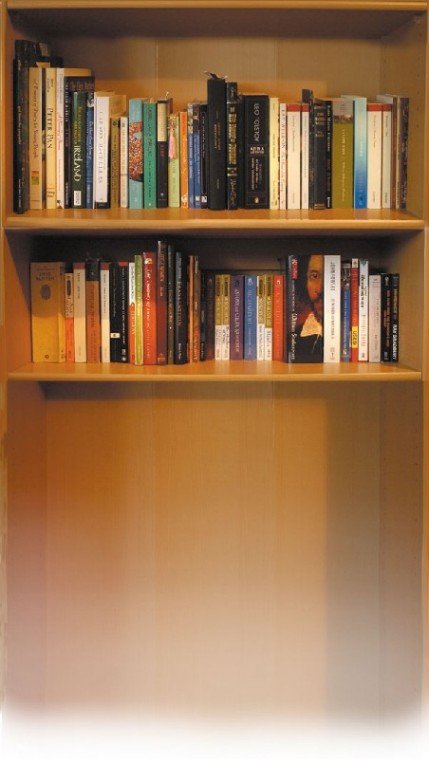When creating your own personal collection of books at home,
what should be included? Space, personal taste and organization
dictate selections
Next to the couch, books are stacked precariously high. A gaggle of best-selling thrillers have found their way under the bed.
One shelf in the entertainment center that was dedicated to storing books has become crammed with as many books as the small space will allow. In the garage, a box full of old college text books, reference books and children’s books sits collecting dust. If any of this sounds familiar, it’s time to organize your home library.
Inclusion
Deciding what to include in your home library starts with how much room you have. If space is limited, you’ll have to be more judicious than if you had many shelves to fill.
“If you’re only dealing with a couple of bookshelves, the selection (for your home library) is going to be crucial,” said Lani Yoshimura, community librarian at the Gilroy Public Library. “Is it going to be a few favorites? Or references you’ll use throughout the year, such as a dictionary or reference books? It’s a very personal choice.”
Though the library is always available to communities, books in people’s homes are often much more personal, Yoshimura said. She still has the first book ever given to her, an audubon book from her grandfather, and her Junior Betty Crocker Cookbook from her Girl Scout days.
Yoshimura also has an extensive collection of dictionaries and children’s picture books.
“What you have at home will sustain you in a way, and it may shepherd you through life. There are those books you just don’t want to return to the library and that you will read over and over again. You can have books from the past and from the present, and there are books you will eventually get rid of, but in a way, you’ll see yourself in the shelves.”
Organization
When putting your home library to use, it’s important to be able to find what book you want.
“I think your home library is your personal expression, and you let your own likes and quirkiness come out,” said Cinda Meister, owner of BookSmart in Morgan Hill. “I’ve seen people organize their books by color and shape because it’s more aesthetically pleasing, and other people organize by categories. If you see my house, I’ve got books spread everywhere, including the floor. Some people use books as decoration, and others just love books and want them around.”
Though how people organize their books at home is a personal process, most people may find it easiest to organize by grouping things that are alike, said Karen Schaffer, interim county librarian for the San Benito County Free Library. For example, if you have books containing Shakespeare’s plays and books written about Shakespeare, it would be helpful to put them together.
Or, if you have several books that are by different authors that don’t seem to fall into any other category, you can group them together in a sort of “miscellaneous” section. One woman put her father’s library in order by a numeric system, Schaffer said, but most people don’t want or need such a formal organization.
“Some people have books at home segregated into different areas, like putting cookbooks in the kitchen, novels in the bedroom, the book you’re currently reading next to your favorite chair and reference in the study,” Yoshimura said. “That’s fine. You can put them all onto shelves in one room, too. It’s your own system, so it’s whatever is most useful to you. Public libraries obviously use the Dewey Decimal system, and it’s interesting that this is how Dewey’s mind worked. You can do the very same thing, creating a depiction of your mind and how you organize your mind, and representing it in the organization of your books.”
Many people choose to follow libraries’ and book stores’ lead by organizing books by topic or genre, and then by the author’s last name.
But is it sacrilege to put William Shakespeare next to Danielle Steele in a home library?
“Actually, I think that’s quite profound,” Yoshimura said. “It all has a place on the shelf, whether it’s Danielle Steele, Shakespeare, The Beatles or someone else. They’re all wonderful pieces, and sometimes a wonderful synergy comes by putting things together that may not seem to jibe. I find great inspiration that you can have Joan Valles next to Adolf Hitler, and they’re not fighting.”
Presentation
When deciding where you actually place your books, the sky – or your imagination – is the limit. At one time, Yoshimura said, she had books in an old refrigerator that she didn’t use. The fridge had shelves, and she made use of them. She also keeps her cookbooks in kitchen cabinets.
Employees at BookSmart said they’ve seen refrigerators used before, as well as small row boats propped up and with shelves installed, and the classic college dorm room bookshelves – the cinder blocks with planks of wood.
Trappist monks in Iowa who hand-make coffins have even reportedly had requests for them to transform their coffins into bookshelves, according to spokesman Brother Paul Andrew in an interview with Web site administrators from www.ncbuy.com.
Whether the books are in a coffin or a simple wooden bookcase, once you’ve got your library set up, Meister recommends using specialized computer systems to help you keep track of the contents of your library. Microsoft Excel spreadsheets also work, she said.
“You just want something that tells you what you have, so you’re not walking into book stores and holding a book saying to yourself, ‘Do I have this already or not?'” Meister explained. “It’s just something to help you be organized.”
And if you decide to lend your books to people, book plates – which are similar to address labels, often saying something such as “This book belongs to …” – are wise investments, Meister said.
“Book plates really increase the chance that you’re going to get your book back,” she said. “Otherwise people forget who they got the book from, or you forget who you lent it to. It’s also a good idea to write down what you lent to who.”












